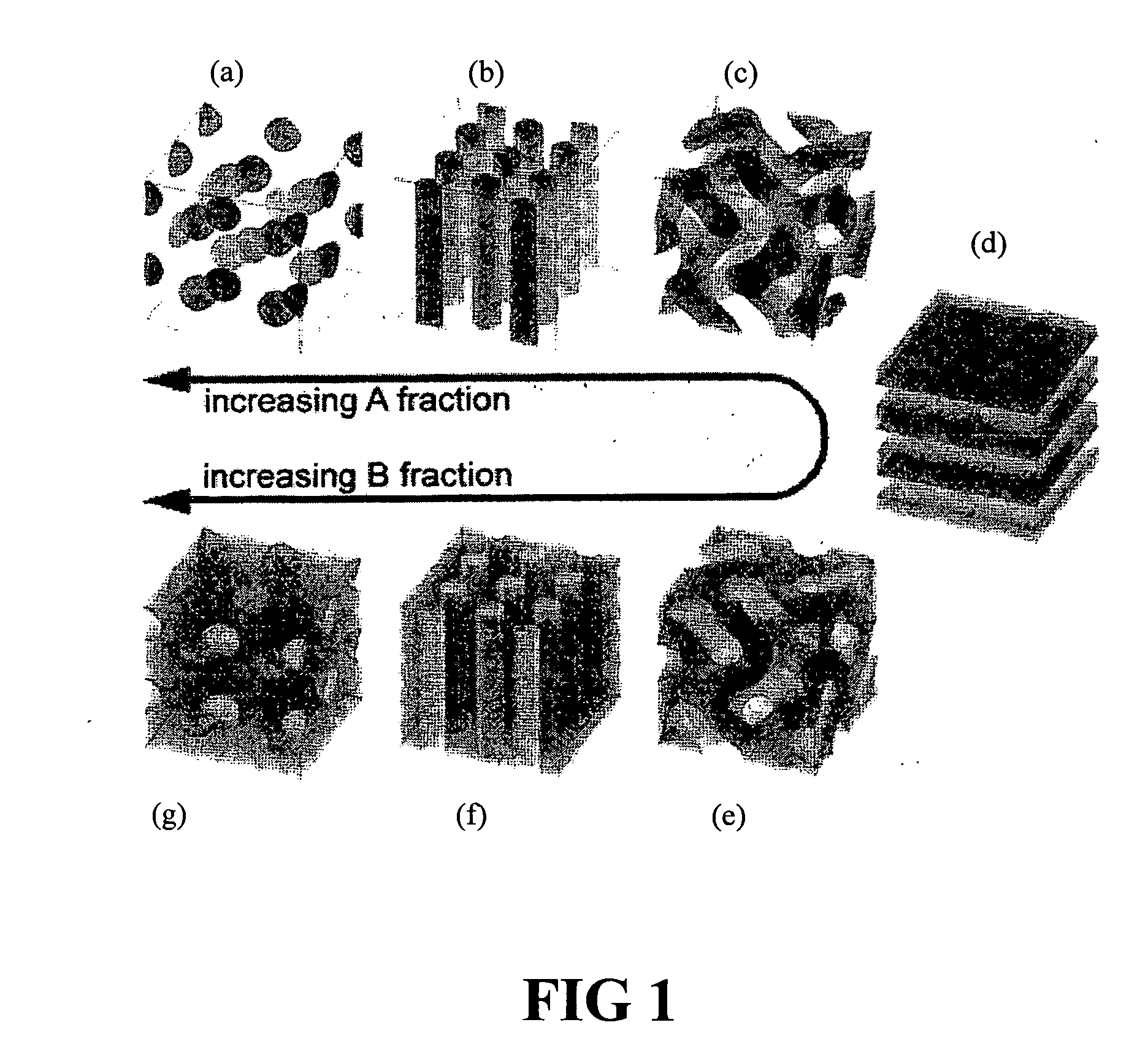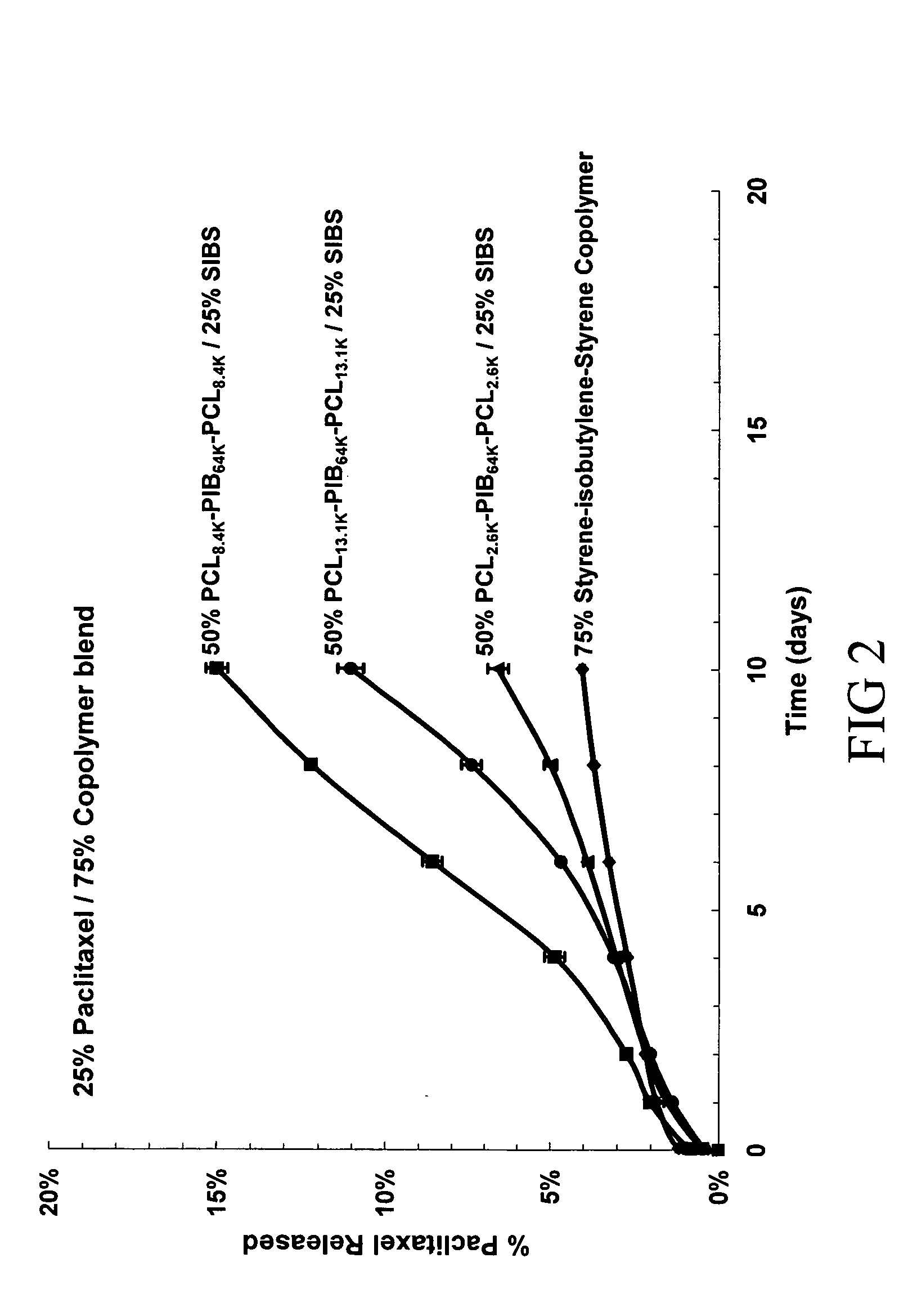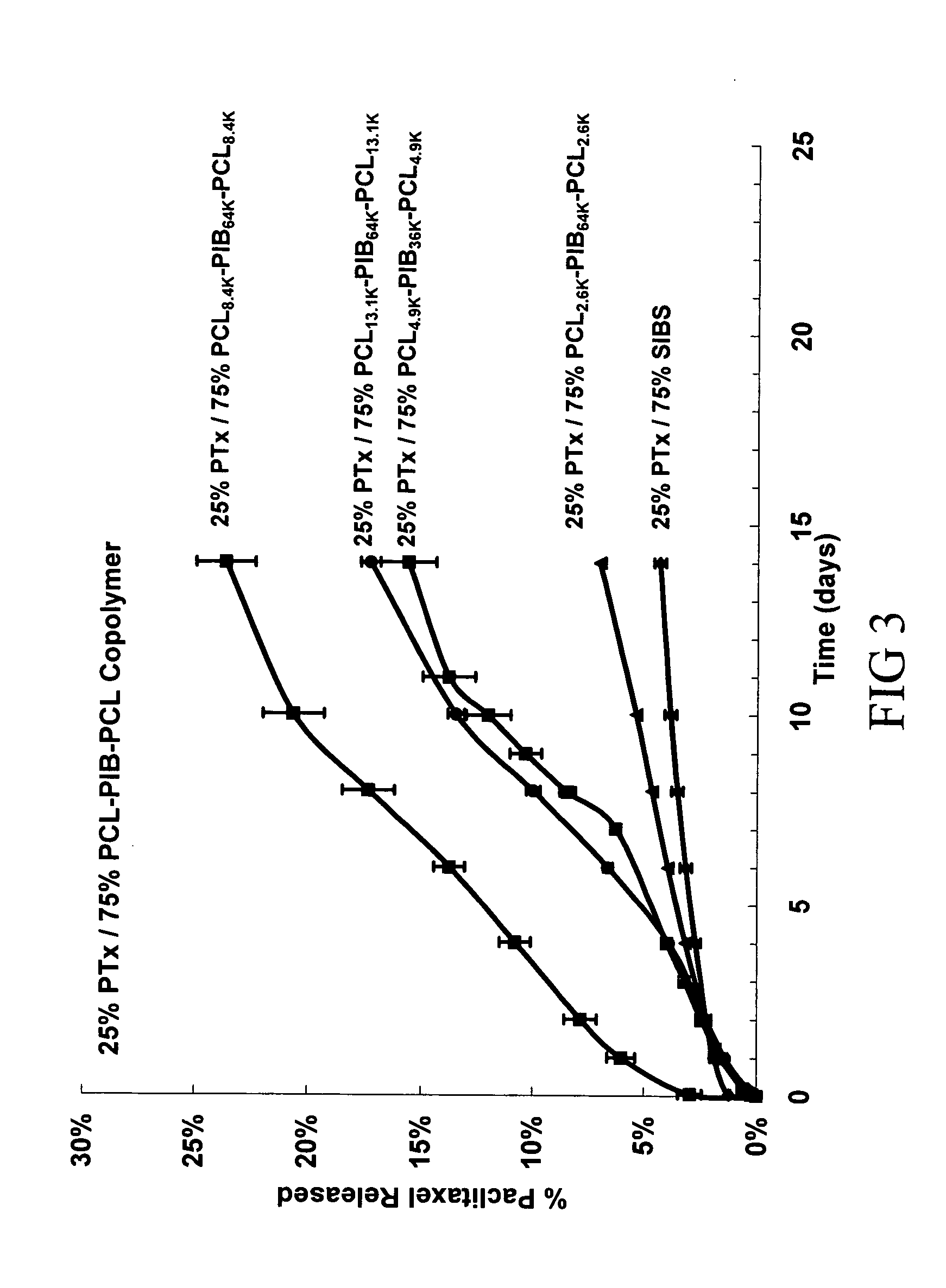Medical devices having porous polymeric regions for controlled drug delivery and regulated biocompatibility
a technology of porous polymeric regions and controlled drug delivery, which is applied in the direction of pharmaceutical delivery mechanism, prosthesis, surgery, etc., can solve the problems of greater challenges in controlling the amount of therapeutic agents released in a specific time interval (e.g., the rate of release), and the release layer of therapeutic agents becomes trapped
- Summary
- Abstract
- Description
- Claims
- Application Information
AI Technical Summary
Benefits of technology
Problems solved by technology
Method used
Image
Examples
example 1
Synthesis and Characterization of Poly(caprolactone)-Polyisobutylene-Poly(caprolactone) Block Copolymer
Block Copolymer Synthesis.
1. Synthesis of Hydroxyl End-Functional Polyisobutylene Macroinitiator
[0121] Polyisobutylene having a carboxylate end group is synthesized via a living cationic polymerization process. [Isobutylene]=0.09 M, [2,6-di-tert-butylpyridine (DTBP, Aldrich)]=3×10−3 M as a proton trap, and [2-chloro-2,4,4-trimethylpentane (TMPCl)]=2×10−3 M as an initiator in hexane / methyl chloride (MeCl) (60 / 40 v / v) are added to a prechilled 400 mL round flask. The polymerization of isobutylene is initiated by the addition of TiCl4 stock solution ([TiCl4]=3.6×10−2 M) at −80° C. and is polymerized for 1 hour. The living polyisobutylene is capped in-situ by the addition of 2 equivalents of 1,1-diphenylethylene (DPE, Aldrich) or 1,1-p-ditolylethylene (DTE, Aldrich) stock solution to functionalize the polyisobutylene chain end. After 1 hour capping time, 2 equivalents of [(2-methy...
example 2
Synthesis and Characterization of Poly(Lactic Acid)-Polyisobutylene-Poly(Lactic Acid) Triblock Copolymer
Block Copolymer Synthesis.
1. Synthesis of Dihydroxyl End-Functional Polyisobutylene Macroinitiator
[0128] Polyisobutylene having two hydroxyl end functional groups is synthesized as an initiator for living cationic polymerization of polyisobutylene. As an alternative to the synthesis method provided above, a dihydroxyl end-functional polyisobutylene macroinitiator is formulated via the preparation of a di-aldehyde-telechelic polyisobutylene.
[0129] The di-allyl-terminated polyisobutylene is prepared in dry-box. 300 mL of anhydrous hexane, 200 mL of methyl chloride, 40.0 mL of IB, 0.125 mL of DTBP and 0.1982 g of initiator (5-tert-butyl-1,3-bis(2-methoxy-2-propyl) benzene) is mixed up in a 1 L three neck flask equipped with a mechanical stirrer at −80° C. The reaction is started by the addition of 2.5 mL of TiCl4 dissolved in 10 mL of anhydrous hexane. After 1 hour reaction tim...
example 3
Stent Coatings
1. Preparation of Coatings
[0135] Solutions are provided that contain 25 wt % tetrahydrofuran (THF), 74 wt % toluene, and 1 wt % solids (paclitaxel and polymer). All solutions are prepared by mixing the paclitaxel and THF until the paclitaxel is thoroughly dissolved, then adding the polymer, followed by the toluene, thoroughly mixing (e.g., overnight), and filtering.
[0136] Solutions were made containing the following: (1) 0.25 wt % paclitaxel and 0.75 wt % of a copolymer blend comprising polystyrene-polyisobutylene-polystyrene (0.25 wt %) triblock copolymer (SIBS), as described in United States Patent Application 20020107330 and U.S. Pat. No. 6,545,097 entitled “Drug delivery compositions and medical devices containing block copolymer,” and polycaprolactone-polyisobutylene-polycaprolactone (0.50 wt %) triblock copolymer (PCL-PIB-PCL); (2) 0.25 wt % paclitaxel 0.75 wt % of a copolymer blend comprising 0.25 wt % PCL-PIB-PCL and 0.50 wt % SIBS; (3) 0.25 wt % paclitaxel...
PUM
| Property | Measurement | Unit |
|---|---|---|
| wt % | aaaaa | aaaaa |
| length | aaaaa | aaaaa |
| length | aaaaa | aaaaa |
Abstract
Description
Claims
Application Information
 Login to View More
Login to View More - R&D
- Intellectual Property
- Life Sciences
- Materials
- Tech Scout
- Unparalleled Data Quality
- Higher Quality Content
- 60% Fewer Hallucinations
Browse by: Latest US Patents, China's latest patents, Technical Efficacy Thesaurus, Application Domain, Technology Topic, Popular Technical Reports.
© 2025 PatSnap. All rights reserved.Legal|Privacy policy|Modern Slavery Act Transparency Statement|Sitemap|About US| Contact US: help@patsnap.com



